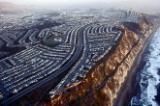Development Pressure
While many human activities can alter natural habitats, the conversion of green space to urban and suburban uses is the fastest growing threat to the nation’s plants,animals, and open spaces.
Decades of poorly planned commercial and residential development have taken a huge toll on the quality of both our lives and the natural environment. Even at low densities, poorly planned development can fragment natural habitats, greatly reducing the value of remaining open spaces for biodiversity, recreation, and other uses. Increased commuting times and distances increases traffic as well as air and water pollution. Roads and other impermeable hardscapes increase storm run-off, diminish water quality, and reduce options for outdoor recreation. In all, creating the infrastructure -- the buildings, roads, sewers, and water systems -- required to accommodate and support such patterns has had the unintended effect of allocating public resources to diminish the public’s health and well-being.
If development continues at prevailing densities, land will be consumed at an even faster rate than population grows, particularly in rural and suburban areas. This expanding footprint will put additional pressure on diminishing wildlife resources and their habitats, and has the potential to drive more plants and animals toward extinction.
The nation’s wildlife heritage is not just restricted to the pristine habitats. As our sprawling communities push further and further out, the remaining farmland and wildlands in and around cities and suburbs disappear, taking with them the habitats on which wildlife depend.
Even those lands that will never be restored to natural conditions often serve as essential buffers for nearby wildlife reserves or connecting corridors between reserves. For example, in south Florida cattle ranches with a mosaic of forest patches provide valuable habitat for the endangered Florida panther, the Florida black bear, and sandhill cranes.
As recent fire seasons have shown, building communities and homes in wildland areas where periodic fires are a natural phenomenon can be hazardous to property and lives. Even outside such incendiary circumstances, so long as farmland, forests, wetlands, and grasslands are protected from development, they have considerable potential conservation value.
The very nature of our communities is at stake.
Why should the disappearance of plants, animals, and habitats concern everyday citizens? Because we literally cannot live without the services they collectively provide – water purification, aquifer recharge, crop pollination, carbon storage, and climate and flood regulation, to name just a few. The removal of any single species from a natural system can affect many others, leading to unpredictable chain reactions that can harm human health and economic viability.
The conversion of land from rural to urban or suburban is generally permanent, and in addition to destroying and fragmenting habitat, it often leads to further development. If the U.S. is to protect open space and its associated economic, utilitarian, recreational, aesthetic, spiritual, or intrinsic benefits for future generations, we must champion the idea that our communities plan carefully to guide development in ways that leave life-sustaining green infrastructure intact.
Adapted from Ewing, R., J. Kostyack, D. Chen, B. Stein, and M. Ernst, Endangered by Sprawl: How Runaway Development Threatens America’s Wildlife (National Wildlife Federation, Smart Growth America, and NatureServe: Washington, DC, 2005).
Go Straight to Your State
Learn about conservation and open space in your state.




